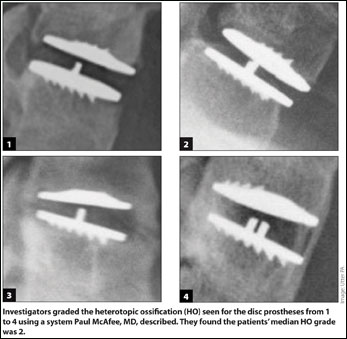Adequate endplate coverage by cervical disc prosthesis may reduce risk of HO
By the 5-year follow-up, endplate coverage was significantly correlated with HO grade.
Recently presented data showed endplate coverage by a cervical disc prosthesis was related to the grade of heterotopic ossification that patients had. Less endplate coverage was statistically significantly correlated to a higher grade of heterotopic ossification.
According to the study findings presented by Philip A. Utter, MD, FAANS, of the Spine Institute of Louisiana in Shreveport, La., these results persisted through 5 years of follow-up.
“Less endplate coverage results in higher endplate HO [heterotopic ossification],” Utter said.
Replacement at continuous levels
Utter told Spine Surgery Today, “HO does occur in some patients after receiving cervical total disc replacement, although patient outcomes are unaffected. The key to minimizing the risk of HO is to understand what factors contribute to its development. The preliminary results of correlation analyses from the Mobi-C (LDR) IDE trial indicate less anterior-posterior coverage is significantly related to higher HO grades. Male patients and patients with higher BMI may also be at greater risk of grades 3 and 4 HO. Further study of Mobi-C and other disc prostheses will continue to isolate contributing factors in the development of HO.”

The study that Utter and colleagues conducted involved an analysis of HO rates in 389 patients, of whom 164 patients underwent one-level cervical total disc replacement (CTDR) and 225 patients underwent two-level CTDR from C3 to C7. The levels treated needed to be contiguous for patients to be included in the two-level study.
The BMI-HO connection
Utter and colleagues used the typical HO grading system described by Paul McAfee, MD, in which grades 1 to 2 meant no restricted motion and grades 3 to 4 meant restricted motion due to the presence of HO.
The analysis showed patient age was not related to increases in HO; however, patient BMI was found to have a correlation in certain cases, according to Utter.
“For BMI with one-level total disc replacement, we did find that patients who had a higher BMI were more likely to have heterotopic ossification that caused a restriction of range of motion, but we did not see that in two-level patients,” he said.

By the 5-year follow-up, the researchers found the patients’ median HO grade was 2, and endplate coverage was significantly correlated with HO grade, with less endplate coverage correlating to a higher grade of HO. In addition, median endplate coverage was found to be significantly greater for patients who underwent one-level procedures with HO grades 0, 1 and 2. Although patients who underwent two-level CTDR with HO grades of 0, 1 and 2 were found to have higher endplate coverage, this was not considered significant, according to the researchers.
HO grade vs NDI, other scores
HO grade was not found in the study to have a significant correlation to Neck Disability Index, VAS for neck pain or SF-12 Physical Composite Scale scores.
Utter said during his presentation that he often tells his patients postoperatively about their HO risk so that it is not a surprise should they develop it. – by Susan M. Rapp
- Reference:
- Utter PA, et al. Paper #734. Presented at: American Association of Neurological Surgeons Annual Meeting; May 2-6, 2016; Washington, D.C.
- For more information:
- Philip A. Utter, MD, FAANS, can be reached at Spine Institute of Louisiana, 1500 Line Ave., Suite 200A, Shreveport, LA 71101; email: autter@louisianaspine.org.
Disclosure: Utter reports no relevant financial disclosures.
